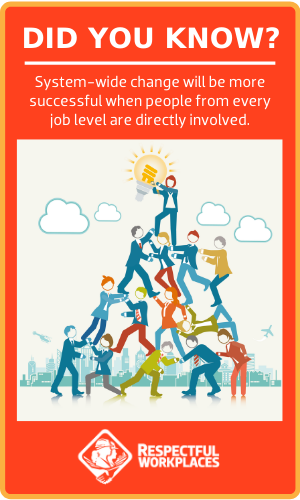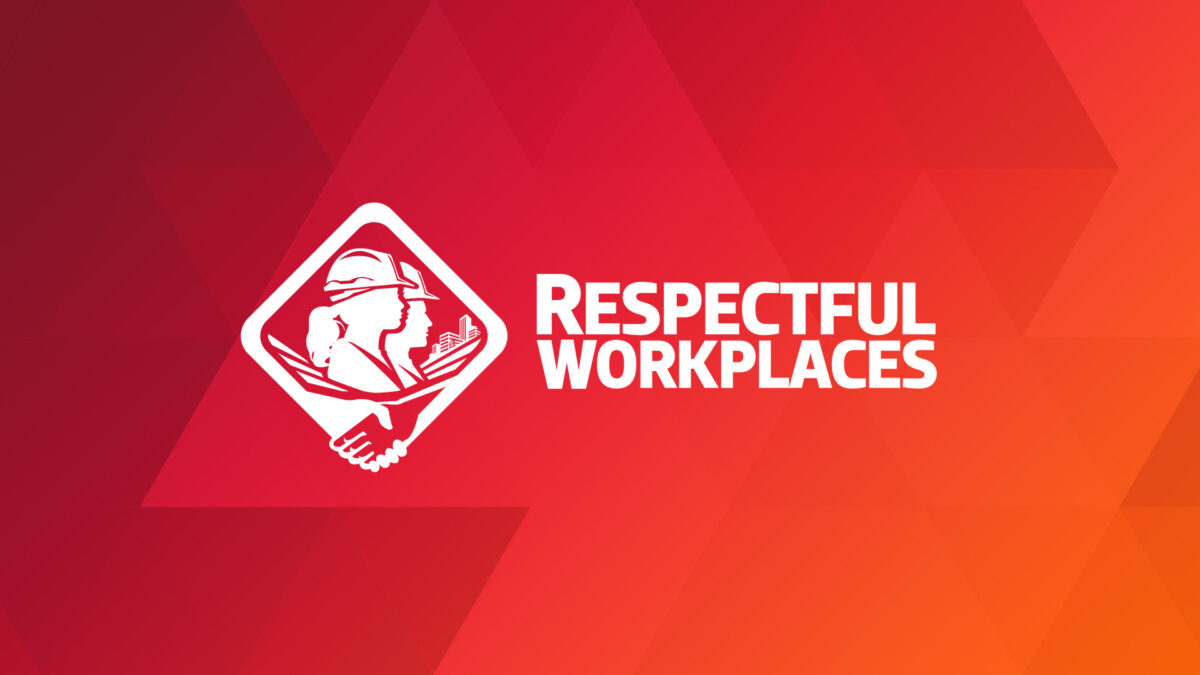Does your organization have an inclusion plan that directly involves people from every job level?

In our previous blog (Blog #53), we discussed how bias becomes systemic when many decisions are influenced by bias throughout linked processes. Bias in the processes of recruitment and retention can have a cumulative impact on the career opportunities of Black, Indigenous, and People of Colour.
Systems of recruitment and retention are complex and involve people from every job level. To reduce systemic bias, it is not sufficient to simply train people on unconscious bias, or for leaders to announce plans and goals. To make system-wide change, people from every job level should be directly involved in the planning and implementation of an inclusion initiative.
3 strategies to directly involve people from all job levels in the planning and implementation of an inclusion initiative:
1. Develop the skills of the leadership team.
Researchers are unanimous that the quality of leadership predicts both the perceived and actual success of system-wide change. A study by Catalyst found that training leaders in change management skills helps them to be more effective in system-wide change initiatives such as inclusion.
Change leadership skills include:
– Communicating about the initiative in a way that includes two-way feedback
– Establishing powerful cross-functional groups to drive the change
– Empowering those affected by the change through engagement
– Negotiating conflicts caused by the changes
2. Consider the day-to-day impact on frontline workers.
Commitment by frontline workers will be affected if they perceive that an initiative represents a disruption to existing work routines, requires significant effort beyond what was previously expected of them, and/or if they lack the knowledge, skills, or capacity to comply with or follow new requirements or expectations. Strategies to increase engagement include coaching and training, sharing information, and holding problem-solving forums.
3. Build the commitment of middle managers and supervisors.
Middle managers and supervisors are critical to the success of any change initiative, but often do not get sufficient support. If workers return from training only to find that their supervisor doesn’t understand or support the intent of the initiative, even the most motivated worker will quickly lose the motivation to integrate the training.
Strategies include involving managers and supervisors in the change-planning and implementation process, empowering them to take ownership of the inclusion initiative, and providing training to develop the skills and confidence to contribute to the initiative.
To create an organization that is inclusive of Black, Indigenous, and People of Colour, there must be system-wide shifts. This requires addressing how bias may be influencing many decisions made by people from all job levels of an organization. An inclusion initiative will be more successful when it develops strategies to include people from all job levels in the planning and implementation of the initiative.
—
The BuildForce Respectful Workplace Online Toolkit provides three tools based on the proven practices of respectful and inclusive organizations to help address systemic racism: the Online Self-Assessment Tool, a Policy Framework and Implementation Guide, and the online course, “Working in a Respectful and Inclusive Workplace.”
The management Self-Assessment Tool provides a blueprint of the actions required to identify and re-work systems where unconscious bias may be impacting management goals to be fair and inclusive in their recruitment, promotion, and retention practices.
Also look for the new BuildForce online course, to be released late summer 2021, to help leaders and managers to understand systemic racism. BuildForce is also developing a new module for the “Working in a Respectful and Inclusive Workplace” course to help workers develop awareness about systemic racism, also to be released in 2021.
For more info:
- Catalyst. “Strategy Matters: Evaluating Company Approaches for Creating Inclusive Workplaces.” 2010. See www.catalyst.org/research/strategy-matters-evaluating-company-approaches-for-creating-inclusive-workplaces.
- Donovan, Mason and Mark Kaplan. “The Inclusion Dividend, 2nd Ed.” DG Press, New Hampshire, U.S., 2019.
Read from the beginning. Click here to start at Part 1.
What can an effective Respectful and Inclusive Workplace Program deliver?
- Become an employer of choice – attract, retain, and advance top talent from all sources of labour
- Unlock collaboration and innovation – create high-performing teams through diversity of thought and experience
- Build your brand – your organization will gain a competitive edge as a leader and innovator
Get started today!
The BuildForce Canada Online Respectful and Inclusive Workplace Toolkit includes:
- the Respectful Workplace Online Self-Assessment Tool to assist organization leadership in assessing their current situation and identifying where they may need to make changes
- the Respectful Workplace Policy Framework and Implementation Guide to assist organizations in creating and implementing a policy that supports a respectful and inclusive workplace
- the Respectful Workplace Online Training Course to train workers on how to create and support a respectful and inclusive workplace
- the online course Introduction to Understanding Systemic Racism: A Guide for Leaders and Managers
All the resources you need to create and support a respectful and inclusive workplace!

Respectful and Inclusive Workplaces
